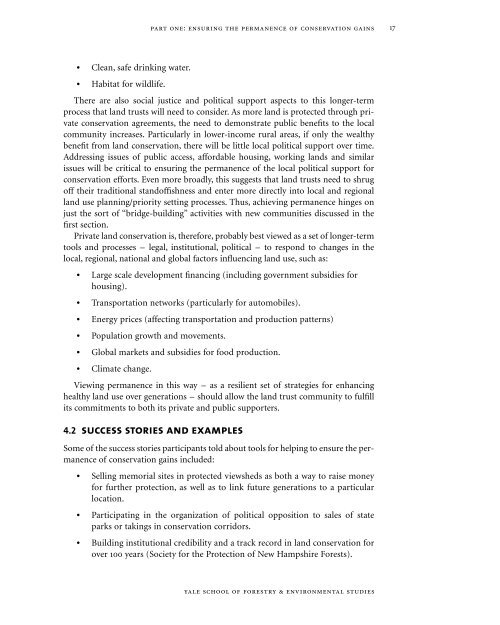16strategies <strong>for</strong> <strong>the</strong> future <strong>of</strong> conservation: 2006 workshopto enhance community stability by reducing <strong>the</strong> pace <strong>of</strong> change. O<strong>the</strong>rs are lookingto fill an emotional need by controlling <strong>the</strong> use <strong>of</strong> a place <strong>the</strong>y love once <strong>the</strong>y are gone.Still o<strong>the</strong>rs are looking to fill a spiritual need to connect to something bigger by protectinga natural area from human destruction.In reality, all things change. Biophysically, many believe that climate change willbring great shifts in <strong>the</strong> distribution <strong>of</strong> plants and animals across <strong>the</strong> US.Technologically, humans’ abilities to monitor and manipulate <strong>the</strong> naturalenvironment will continue to grow – <strong>for</strong> both good and ill. Legally, <strong>the</strong> ownership <strong>of</strong>land under easement will change, <strong>of</strong>ten bringing different views on <strong>the</strong> importance <strong>of</strong>conservation values. Easements may be amended to reflect <strong>the</strong> wishes <strong>of</strong> bothlandowners and land trusts. Protected land may be “taken” by governments <strong>for</strong> publicpurposes ranging from jails, to infrastructure corridors, to more “publicly valuable”private development. Institutionally, land trusts may come and go. Economically,major shifts in global production and consumption patterns will continue to occur.Socially, <strong>the</strong> make-up <strong>of</strong> communities will change and with it, <strong>the</strong>ir attitudes towardnature. Politically, elected <strong>of</strong>ficial and civil servants will take all <strong>of</strong> <strong>the</strong>se changes intoaccount when promoting what <strong>the</strong>y believe to be <strong>the</strong> “best” land uses in <strong>the</strong>ircommunities.As such, land trusts must <strong>of</strong>fer both <strong>the</strong> use <strong>of</strong> “permanent” legal tools, as well asan appropriately flexible process <strong>for</strong> enhancing conservation values in <strong>the</strong> face <strong>of</strong>change over <strong>the</strong> longer term. The core <strong>of</strong> this process is building and maintaining <strong>the</strong>“ethos” mentioned earlier so as to turn land trusts into valued communityinstitutions over time. Doing so has both internal and external aspects.Internally, land trusts need to make sure that <strong>the</strong>y are durable and credibleinstitutions with a track record <strong>of</strong> bringing value – public benefit – to both <strong>the</strong>irdonors and <strong>the</strong> broader community. Stable funding, stewardship endowments/programs, high quality internal governance, a breadth <strong>of</strong> perspectives on a committedboard, a clear mission and quality staff are all essentials. Navigating <strong>the</strong> conflicts thatcan arise among a land trust’s obligations to its donors, <strong>the</strong> individual landownerswith which it works and <strong>the</strong> broader community in which resides requires particularcare. Finding compatible, continuing revenue streams from protected areas – fromuser fees to sales <strong>of</strong> ecosystem services – will also help land trusts endure over time.Externally, land trusts need to build and maintain a dense web <strong>of</strong> relationships thatwill help sustain <strong>the</strong>ir missions in <strong>the</strong> long term. This means expanding <strong>the</strong> focus toinclude both donors <strong>of</strong> unprotected land and users <strong>of</strong> protected land – making surethat local communities share in <strong>the</strong> benefits <strong>of</strong> conservation land so that <strong>the</strong>y willfight <strong>for</strong> its continued protection in <strong>the</strong> future, whe<strong>the</strong>r that be from easementviolations, improper amendments or threatened takings.As discussed above, making <strong>the</strong> case <strong>for</strong> conservation requires that land trustslisten to affected communities and <strong>the</strong>n connect <strong>the</strong> message to <strong>the</strong>ir most deeplyheld values, such as:●●Healthy communities – economically, environmentally and socially.Safe places <strong>for</strong> kids to play.yale school <strong>of</strong> <strong>for</strong>estry & environmental studies
part one: ensuring <strong>the</strong> permanence <strong>of</strong> conservation gains17●●Clean, safe drinking water.Habitat <strong>for</strong> wildlife.There are also social justice and political support aspects to this longer-termprocess that land trusts will need to consider. As more land is protected through privateconservation agreements, <strong>the</strong> need to demonstrate public benefits to <strong>the</strong> localcommunity increases. Particularly in lower-income rural areas, if only <strong>the</strong> wealthybenefit from land conservation, <strong>the</strong>re will be little local political support over time.Addressing issues <strong>of</strong> public access, af<strong>for</strong>dable housing, working lands and similarissues will be critical to ensuring <strong>the</strong> permanence <strong>of</strong> <strong>the</strong> local political support <strong>for</strong>conservation ef<strong>for</strong>ts. Even more broadly, this suggests that land trusts need to shrug<strong>of</strong>f <strong>the</strong>ir traditional stand<strong>of</strong>fishness and enter more directly into local and regionalland use planning/priority setting processes. Thus, achieving permanence hinges onjust <strong>the</strong> sort <strong>of</strong> “bridge-building” activities with new communities discussed in <strong>the</strong>first section.Private land conservation is, <strong>the</strong>re<strong>for</strong>e, probably best viewed as a set <strong>of</strong> longer-termtools and processes – legal, institutional, political – to respond to changes in <strong>the</strong>local, regional, national and global factors influencing land use, such as:●●●●●●Large scale development financing (including government subsidies <strong>for</strong>housing).Transportation networks (particularly <strong>for</strong> automobiles).Energy prices (affecting transportation and production patterns)Population growth and movements.Global markets and subsidies <strong>for</strong> food production.Climate change.Viewing permanence in this way – as a resilient set <strong>of</strong> strategies <strong>for</strong> enhancinghealthy land use over generations – should allow <strong>the</strong> land trust community to fulfillits commitments to both its private and public supporters.4.2 success stories and examplesSome <strong>of</strong> <strong>the</strong> success stories participants told about tools <strong>for</strong> helping to ensure <strong>the</strong> permanence<strong>of</strong> conservation gains included:●●●Selling memorial sites in protected viewsheds as both a way to raise money<strong>for</strong> fur<strong>the</strong>r protection, as well as to link future generations to a particularlocation.Participating in <strong>the</strong> organization <strong>of</strong> political opposition to sales <strong>of</strong> stateparks or takings in conservation corridors.Building institutional credibility and a track record in land conservation <strong>for</strong>over 100 years (Society <strong>for</strong> <strong>the</strong> Protection <strong>of</strong> New Hampshire Forests).yale school <strong>of</strong> <strong>for</strong>estry & environmental studies
















